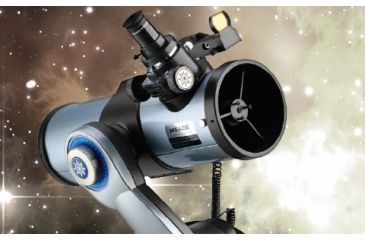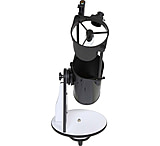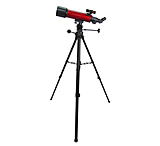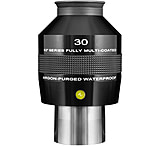Congratulations and welcome to the world of astronomy. Perhaps you bought a new telescope and are wondering what accessories you shold buy, or maybe you have an older space telescope in need of new eyepieces. Telescope eyepieces are the most important accessory for a telescope. Why? Inexpensive telescopes are supplied with low-quality eyepieces. Upgrading to higher quality eyepieces is the easiest way to improve performance. Expensive telescopes are only supplied with one eyepiece - not enough to cover all the basics. The manufacturer leaves it to you to choose more eyepieces based on your observing preferences and budget.![]()
Do You Need to Have the Same Brand of Telescope & Eyepiece?
Don't limit yourself to a particular brand of eyepiece. Even if you have a Meade telescope, you can use Celestron eyepieces and visa versa. With only a rare exception, you can use any brand of eyepiece in your telescope as long as the barrel size of the eyepiece matches the barrel size of your focuser. If in doubt, measure the size of the opening in the focuser of your telescope. It will be 1in (.965in), 1.25in, or 2in. The 1.25in barrel size eyepiece is almost universally standard these days. A few older scopes use much inferior .965in (one inch) eyepieces, and a few scopes can use the larger 2in eyepieces. If you have just purchased an astronomical telescope, odds are it uses 1.25in eyepieces. Even if it can take 2in eyepieces, it probably has an adapter available that allows you to use 1.25in eyepieces.
How Many Telescope Eyepieces Do I Need?
Since you will be viewing a wide variety of objects, you need to cover several magnification ranges. With telescopes, we change magnification by changing eyepieces. You will want a high magnification eyepiece for viewing the moon and planets. You will want a medium magnification eyepiece for looking at brighter deep-sky objects (star clusters, nebulae and galaxies) or when you need to check for more detail in these objects. You will want a low magnification eyepiece for faint deep-sky objects or very large objects. A low-power eyepiece is also the eyepiece you most use for locating objects (widest field of view).
In other words, three eyepieces as a minimum works the best. Another possibility is two eyepieces and a barlow lens. A barlow lens attaches to an eyepiece and doubles or triples the magnification of the eyepiece, depending on the magnification of the barlow. Just be sure the barlow doesn't give you too much magnification.
Numbers on Telescope Eyepieces Explained
That number you see on a telescope eyepiece, or listed in the description of an eyepiece, is not the magnification. It is the focal length of the eyepiece. Why not the magnification? The same eyepiece can be used in many different telescopes and can produce different magnifications, depending on the focal length of the telescope.
Letter(s) on your Telescope Eyepiece Explained
The letter is not the brand of the eyepiece. It is an abbreviation for the eyepiece design - the combination and type of lenses used. The most common design these days is the Plossl (P). Inexpensive telescopes are often supplied with inferior designs, such as the Huygens (H), Ramsden (R), and so on. Premium eyepieces are typically labeled with the complete name.
2in Eyepieces vs. 1.25in Eyepieces
Two inch eyepieces exist simply because you cannot squeeze a combination of long focal lengths (low magnification) and wide fields of view in a narrow 1.25in barrel. It's a matter of lens size needed, not optical quality. You only need a 2in size eyepiece when you are exploring for low magnification eyepieces with wide fields of view. You do not need a 2in barrel on a short focal length eyepiece, even on the very finest 1.25in short focal length eyepiece. Also, before you decide to buy that premium 2in eyepiece, be sure your telescope can accept one. Not all telescopes are compatible with 2in eyepieces or offer a way to convert a focuser to 2in eyepieces.
Eyepiece Prices Explained
In general, you pay more to get:
- Better sharpness, not just at the center of the field, but also out to the very edge.
- Wider apparent fields of view. Telescope eyepieces that excel at both use complex lens systems of the highest quality and these do not come cheap. Using a premium eyepiece cannot always guarantee that you will see more, but using a premium eyepiece will always bring out the best in your telescope and will always make your telescope more enjoyable to use. Once you have used a premium telescope eyepiece, it is very difficult to settle for less.
To determine the magnification of an eyepiece with your telescope, first check the focal length (length of the optical system in millimeters) of your telescope. This is nearly always marked on the telescope as an f (focal length) number. At the very least, it will be listed in the specifications or your telescope instruction manual. To determine magnification of a specific eyepiece in your own telescope, simply divide the focal length of your telescope by the focal length of the eyepiece. For example, in a 1000mm focal length telescope, a 25mm eyepiece produces 40x. A 10mm eyepiece produces 100x. As you can see, the magnification produced by a telescope eyepiece goes up as the focal length number of the telescope eyepiece goes down.
How Much Magnification Do I Need?
Good question and one you need to answer, carefully. The single most common beginner's mistake is to use too much magnification. Magnification has much less to do with astronomy than first-timers think. Astronomy is more about seeing faint objects, not about magnifying them, and seeing faint objects is more about telescope aperture, in terms of mirror or objective size, rather than magnification.
Going overboard on magnification not only destroys image quality, it also makes your astronomy telescope much harder to use. A rule of thumb for all optical devices is that as magnification goes up, image quality, image brightness, field of view, and image steadiness all go down. If you are experiencing poor image quality with your telescope, if objects are too hard to find (narrow field of view), or if the telescope shakes and vibrates too much, your magnification is likely too high. This is especially serious when it comes to the many faint objects we want to see, since we lose image brightness quickly as magnification goes up. Less magnification is more for much of astronomy.
What Does Maximum Useable Magnification Mean?
"Maximum useable magnification" listings by manufacturers are basically advertising nonsense. Ignore them. The amount of magnification you use will depend on a variety of factors - the type of object being observed, observing conditions of the atmosphere (very important), the size and quality of your scope, your observing experience, as well as your personal preferences.
Guideline for Telescope Magnification
There is no magic formula for determining maximum magnification for your optical telescope, but the oft quoted rule of thumb of 30-50x per inch of telescope sizes as a maximum is a good place to start. Why 30-50x, instead of just 50x? The atmosphere is a significant factor in determining how much magnification you can use on a given night, and conditions change, nightly, and even by the hour. On nights when the atmosphere is turbulent, you will be down around the 30x or less per inch of telescope if you want good image quality. On nights of exceptional steadiness, you may be able to use 50x per inch of telescope size. Keep in mind that the atmosphere and mount problems limit magnification to 300x or a bit more for any telescope, no matter how large, and even then, that much will be used only rarely. Most of the time you will use much, much less.
Using this guideline, we can see that 120x is a real stretch for a 60mm (2.4in) scope. You can certainly get more magnification out of a 60mm telescope by changing eyepieces or using a barlow, but images will be blurry and indistinct. This is an example of nonsense magnification and it is often advertised on cheap telescopes as a sales pitch. When we pass the point where adding more magnification gives us less detail, not more, we know we are using too much magnification. Using these same guidelines we can also see that the same 120x is hardly a challenge for even a 127mm (5in) telescope. If you want to see more, use a larger telescope, not more magnification.
Telescope Field of View
This is the amount of space you see around an object when you look through the eyepiece. Given the same magnification, a wide-angle design shows more space around the object than a standard design. Wide angle designs produce a more pleasing view or wow factor, especially when viewing large star clusters and nebulae. If your telescope mount is not motorized, a wide-angle eyepiece also means you don't have to move the telescope as much to keep the object centered in the eyepiece.
Determining Field of View
Two things determine the field of view when using an eyepiece. The first is the magnification. As magnification goes up, field of view goes down. This is a basic law of all optics. The second is a feature called apparent field of view listed for the eyepiece. You can find this in the specs for the eyepiece. Think of apparent field of view as potential field of view. If you have two 10mm eyepieces, one with an apparent field of view of 52 degrees and one with an apparent field of view of 72 degrees, both produce exactly the same magnification since they are both 10mm eyepieces, but you get a wider field of view with the 72 degree model.
Great, but what if you are comparing an 8mm eyepiece with a 72 degree apparent field of view with a 10mm eyepiece with a 52 degree field of view? In terms of magnification, we should get a wider field of view with the 10mm (lower magnification), right? According to apparent field of view, we should get a wider field of view with the 72 degree version. Will the eyepiece that produces the widest field of view please stand up!
To determine the actual or true (sometimes called angular) field of view that each eyepiece produces in your specific telescope is simple. Divide the apparent field of view of the eyepiece by the magnification the eyepiece produces in your telescope. If you have a telescope with a 1000mm focal length, the 10mm eyepiece produces 100x (1000mm divided by 10mm). This 10mm eyepiece has a 52 degree field of view, so we divide 52 degrees by 100x and we get a true field of .52 degrees. The 8mm eyepiece in your telescope produces 125x (1000mm divided by 8mm). This 8mm eyepiece has a 72 degree apparent field of view so we divide 72 degrees by 125x and we get .57 degrees. So the 8mm eyepiece gives us not only more magnification, but also a very slightly wider field of view.
Make sure to check out our other Telescope How-to Guides to learn more about buying the best telescope and other observation tips to assist your stargazing journey!












